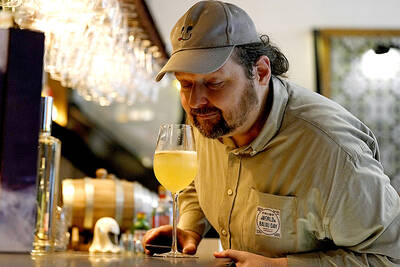Stencil and graffiti artist Kea couldn’t have imagined that one day he’d be working on the walls of Taipei City Hall. Routinely nabbed for spraying less famous buildings around the capital, he sometimes found himself spending the night in detention at a police station.
“[The police] were usually curious and didn’t lecture me too much about what I was doing,” Kea, 29, told the Taipei Times on Tuesday night in the plaza across from the entrance of Taipei City Hall where he was checking out his latest handiwork. “Besides, I was trying to beautify not disfigure the [urban] scenery.”
Beautify is exactly what Kea has done. But rather than sneaking around in the dead of night graffitiing walls, Kea, along with seven other artists, was invited by the city to project his art on to the front of Taipei City Hall in celebration of this year’s Lantern Festival. The building will undergo a makeover of sorts — though only daily from 7pm to 11pm from today until Feb. 15.
The other artists, who work in a broad range of styles such as calligraphy and Aboriginal art, are Dong Yang Zi (董陽孜), Wu Keng-chen (吳耿禎), Qui Ruo-long (邱若龍), Yan Shui-long (顏水龍), Wu Sheng (吳晟), Qui Xi-xun (邱錫勳) and Xiao Qing-yang (蕭青陽).
“[City Hall’s facade] is like a huge canvas,” said Chris Huang (黃茂嘉), one of the event’s organizers who picked the eight artists. “Some artists had difficulty adjusting to such a large size.”
Huang is the Taiwan representative of Pani Projection and Lighting, the company that operates the 24 large-scale projectors that beam the artists’ images onto City Hall and which has done work for the Rolling Stones, Chemical Brothers and U2. He said the artists were chosen for their diverse ages and skills in their respective fields.
The projections complement the other more traditional festivities that feature various small and large-scale lanterns designed in the shape of the ox.
Lantern Festival celebrations in Taipei will also be held in the Xinyi (信義) business district, including at Sun Yat-sen Memorial Hall and several parks and plazas in the area.
The Taiwan Lantern festival began in 1990 when the Tourism Bureau instituted an annual national show to coincide with the traditional custom of carrying lanterns on the 15th day of the first lunar month of the New Year.
Ilan County was chosen to host this year’s festival, the centerpiece of which is an 18.3m-tall display of a water buffalo tilling a verdant rice paddy, an image that symbolizes prosperity. The opening ceremony begins at the Yilan Sports Park (宜蘭運動公園) on Monday with a fireworks display and runs until Feb. 22.
Taipei City Hall’s caretaker can rest easy as the building will not be plastered with the work of eight graffiti artists as was suggested in yesterday’s edition. The ‘Taipei Times’ regrets the error.

The unexpected collapse of the recall campaigns is being viewed through many lenses, most of them skewed and self-absorbed. The international media unsurprisingly focuses on what they perceive as the message that Taiwanese voters were sending in the failure of the mass recall, especially to China, the US and to friendly Western nations. This made some sense prior to early last month. One of the main arguments used by recall campaigners for recalling Chinese Nationalist Party (KMT) lawmakers was that they were too pro-China, and by extension not to be trusted with defending the nation. Also by extension, that argument could be

Aug. 4 to Aug. 10 When Coca-Cola finally pushed its way into Taiwan’s market in 1968, it allegedly vowed to wipe out its major domestic rival Hey Song within five years. But Hey Song, which began as a manual operation in a family cow shed in 1925, had proven its resilience, surviving numerous setbacks — including the loss of autonomy and nearly all its assets due to the Japanese colonial government’s wartime economic policy. By the 1960s, Hey Song had risen to the top of Taiwan’s beverage industry. This success was driven not only by president Chang Wen-chi’s

Last week, on the heels of the recall election that turned out so badly for Taiwan, came the news that US President Donald Trump had blocked the transit of President William Lai (賴清德) through the US on his way to Latin America. A few days later the international media reported that in June a scheduled visit by Minister of National Defense Wellington Koo (顧立雄) for high level meetings was canceled by the US after China’s President Xi Jinping (習近平) asked Trump to curb US engagement with Taiwan during a June phone call. The cancellation of Lai’s transit was a gaudy

The centuries-old fiery Chinese spirit baijiu (白酒), long associated with business dinners, is being reshaped to appeal to younger generations as its makers adapt to changing times. Mostly distilled from sorghum, the clear but pungent liquor contains as much as 60 percent alcohol. It’s the usual choice for toasts of gan bei (乾杯), the Chinese expression for bottoms up, and raucous drinking games. “If you like to drink spirits and you’ve never had baijiu, it’s kind of like eating noodles but you’ve never had spaghetti,” said Jim Boyce, a Canadian writer and wine expert who founded World Baijiu Day a decade